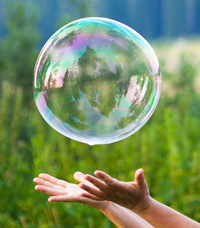Parent Perspective: Understanding Your Role in Your Student's Science Project
Watching kids trying to create super bubbles reinforces the importance of hands-on learning for this science mom—and reminds her that parents should watch but not take over.

A trip to the science museum strikes a chord for a science mom contemplating her role as a parent supporting her son as he tackles his first school science project. Interested in exploring bubble science with your students? Blow the Best Bubbles from Scientific American's Bring Science Home section features a family-friendly version of the Bubble-ology Science Buddies Project Idea.
Last week I was at a local science museum with my kids. As they explored a nearby exhibit, I sat on a bench to wait and ended up watching a group of students who were crowded around a table filled with giant bubble solution and a variety of metal rings. This hands-on exhibit is a perennial favorite. One of my sons always ends up stationed here, and despite the generous size of the table, which invites and enables several kids to get their hands in the bubble liquid at a time, there is always a crowd. For kids of all ages, it seems there is something irresistible about bubbles, especially the allure of creating giant ones. But it's a process that can be more difficult than it looks.
Time and time again, as I watched, kids swished their rings around in the liquid, lifted, and pulled, hoping to drag a ring full of solution from the tray and release an amazing bubble into the air. From where I sat, it was easy to see when someone was pulling too quickly or at the wrong angle. There's definitely a try and try-again mentality needed to figure out what works and what doesn't. As an adult, I felt certain I could have gone over, swirled a ring in the liquid, and pulled up a giant bubble. I probably couldn't have, but I'm sure other parents watching over their children's shoulders felt the same thing. I could see it in their faces. Some of them clearly wanted to step in, to put their own hands on the rings, to guide the process to an exciting conclusion—a beautiful bubble.
But for the student, the hands-on process of interacting with the bubble solution, maneuvering the metal rings, and experimenting with the timing and angle of their movements to find the balance necessary to successfully lift a ring full of the solution from the table and create a bubble is a wonderful learning opportunity. Left to explore, to troubleshoot what was happening when the bubbles popped instantly or when none of the liquid stayed on the rings, gave them the chance to question, to problem solve, to hypothesize (even in their heads), to test (try again), and to learn (whether they realized it or not). Stepping in and creating a wonderful bubble for them might garner some oohs and ahhs, but it wouldn't offer the same moment of experiential learning.
An Important Reminder for Parents
Sitting there and watching the maneuverings at the bubble table was a wonderful diversion. I leaned forward many times, breath held, hoping for a bubble to succeed, and when one of my sons took his place at the table, I watched as he tried several times. I watched, too, as he stopped and watched another kid, a few years older, who was successfully creating some spectacular glycerin displays. My son watched, and then tried again, clearly trying to deduce the difference between that student's technique and his own. From my vantage, it seemed the difference might have something to do with where they were positioned around the table—and possibly from which direction air might have been circulating. I did try and get his attention to suggest he move around the table when another spot opened up, but otherwise, I just watched, enjoyed the momentary pit stop on the bench, and thought about how important it is for parents to support the scientific process without taking over.
Tearing Tape
When we moved to the Tinkering Studio where the kids build marble runs by connecting a variety of odds-and-ends to a peg board, my involvement was needed by one of my sons. He needed me to stand nearby and tear masking tape. That was all. With a marble run, you can test as you add each new element and make adjustments to ensure the marble drops through, finds the next tube, funnel, or railway, and continues to the next step. When something doesn't work out, you move it, alter the angle, change the distance, tighten the tape or holding pegs, or you try another arrangement. He didn't need me to solve what wasn't working. What he needed was a person who could tear tape. The design, the learning, the ultimate vision, and the invention of steps necessary to bring the marble run to fruition were his tasks—and he was up to the challenge.
A Take-Away Lesson
An afternoon at the science museum is always fun for them. Whether they spend time at favorite exhibits or try new ones, they always find plenty to excite and inspire them. They always touch, feel, see, observe, and, most importantly, ask questions. But our afternoon in the giant repurposed airplane hangar where the museum sits was important for me as well. My oldest student is doing his very first school science project this year. For the first time, I am a parent overseeing my own student's science project, most of which needs to be completed at home. On paper, I know the boundaries. I know where to draw the line. I know how the process should go. But when it's your own student, the entire issue of parent involvement takes on new life, and the stumbling blocks seem very clear.
Being the parent supporting and shepherding a student's science project is an interesting position, but it can be a difficult one for parents because it's far too easy to be too involved or too controlling. It's also easy to expect too much, and it can be tempting, sometimes, to try and guide a student's interest during the selection process into an area of parental interest (or expertise). In reality, when a student chooses a project that is about something in which she is interested, and chooses a project that is appropriate for her grade level, skill set, and assignment, she should be able to do most of the project on her own. She may need you to sign the credit card slip for supplies or chauffer her around for materials or a research trip to the library. She may need help with safety steps and with planning. But mostly, her science project should be one she can do independently. Even if a parent itches to be more involved, really, the best thing to do might be to stand back and tear the tape.
A Focus on Hands-on Science
With all of the national attention on science, technology, engineering, and math (STEM) education in recent months, chances are higher than ever before that your K-12 student will be required to do a science project, most of which will be conducted out of the classroom. Given the importance of engaging in hands-on science exploration, this is a wonderful opportunity for students to investigate a scientific question, formulate a hypothesis, run an experiment, and see what happens. As Courtney Corda, Science Buddies Vice President and "Science Mom" recently wrote in an article on parent involvement for PBS Parents, "When your child works on a science project, she is putting the scientific method into action and learning more about how to actively understand the world around her. Her assignment is clear, but as a parent, how involved should you be?"
Science Buddies' Helping at the Right Level at Every Step chart is designed to help parents better understand how to successfully support and encourage a student's science project without stepping over the line and being "too" involved. We've all seen examples of projects (in every academic area) where it is clear that a parent has been heavily involved. Don't be that parent. Know that by letting your student do the work, your student will learn more and will, hopefully, enjoy the process. Don't worry that your student's project, done by your student, might not look as accomplished as another project for which an adult has taken the lead. Science projects shouldn't turn into a competition between parents! Trust that your student's teacher can evaluate your student's project in terms of the assignment and grade-appropriate expectations. The results might not be as perfect as if you'd done the project yourself. That's to be expected. The display board might not look like a professional designer put it together. That's to be expected. The hypothesis might not have been proven true. That happens, and it's absolutely okay! And the project might not be worthy of Nobel attention. Most aren't.
Understand the End Goal
Keep in mind what the K-12 science project is all about. Often the end result of a science project is a small measurable result or confirmation of a single scientific principle. The size of the outcome isn't what's important. Instead, the value comes from seeing the science unfold, putting a question to the test, and examining and interpreting the results. The motor a student makes as a first electronics project may not power a household appliance, but it will teach her about fundamental electronics principles, ones she might use as a launching point for her next experiment or invention.
So, tear the tape if it's needed, help with the procurement of supplies, be available as a sounding board and to help with suggestions when troubleshooting might be required, realize that you may need to assist your student in learning how to pace the stages of the project between the assignment and due dates, and certainly be prepared to join in at any aha moments or when something particularly cool happens in the experiment. But don't take over. It's not your science project. It's your student's. And remember, throughout the process, you get to do something amazing: you get to watch and enjoy seeing your student engage in the scientific process with enthusiasm and confidence. It may be a sideline job, but it's an important one!
(Please see Courtney's full article at PBS Parents: "How to Help Children with Science Projects Without Doing It for Them.")
Categories:
You Might Also Enjoy These Related Posts:
- 15 STEM Gifts & Science Kits You'll Feel Good About Giving
- 13 Boat Science and Submarine Science Projects and Experiments
- July 4th STEM! Summer Science Picks for Independence Day!
- 12 Science Kits for Summer Science Experiments and Discovery
- 15 Science Projects to Make and Give for Father's Day
- Ready, Set, Go! (Awesome Summer Science Experiments)
- Awesome Summer Science Experiments
- 10 STEM Activities with Cardboard Tubes










